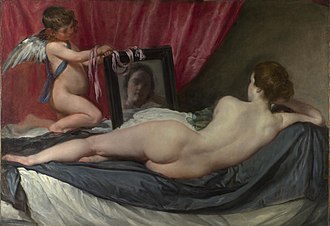
Back فينوس أمام المرآة (لوحة) Arabic روكبى فينوس ARZ Венера з люстэркам BE Gwener ha Kupidon BR Venus del mirall Catalan Venušina toaleta Czech Gwener yn y Drych CY Venus vor dem Spiegel German Venuso ĉe sia spegulo EO Venus del espejo Spanish


The Rokeby Venus (/ˈroʊkbi/ ROHK-bee; also known as The Toilet of Venus, Venus at her Mirror, Venus and Cupid; Whose original title was "The Mirror's Venus" Spanish: La Venus del espejo) is a painting by Diego Velázquez, the leading artist of the Spanish Golden Age. Completed between 1647 and 1651,[3] and probably painted during the artist's visit to Italy, the work depicts the goddess Venus in a sensual pose, lying on a bed with her back facing the viewer, and looking into a mirror held by the Roman god of physical love, her son Cupid. The painting is in the National Gallery, London.
Numerous works, from the ancient to the baroque, have been cited as sources of inspiration for Velázquez. The nude Venuses of the Italian painters, such as Giorgione's Sleeping Venus (c. 1510) and Titian's Venus of Urbino (1538), were the main precedents. In this work, Velázquez combined two established poses for Venus: recumbent on a couch or a bed, and gazing at a mirror. She is often described as looking at herself in the mirror, although this is physically impossible since viewers can see her face reflected in their direction. This phenomenon is known as the Venus effect.[4] In some ways the painting represents a pictorial departure, through its central use of a mirror, and because it shows the body of Venus turned away from the observer of the painting.[5]
The Rokeby Venus is the only surviving female nude by Velázquez. Nudes were extremely rare in seventeenth-century Spanish art,[6] which was policed actively by members of the Spanish Inquisition. Despite this, nudes by foreign artists were keenly collected by the court circle, and this painting was hung in the houses of Spanish courtiers until 1813, when it was brought to England to hang in Rokeby Park, Yorkshire. In 1906, the painting was purchased by National Art Collections Fund for the National Gallery, London. Although it was attacked and badly damaged in 1914 by Canadian suffragette Mary Richardson, it soon was fully restored and returned to display. It was attacked again and its protective glass smashed by Just Stop Oil in 2023.
- ^ According to two seventeenth-century accounts noted in Haskell and Penny 1981, p. 234.
- ^ According to Clark, the Rokeby Venus "ultimately derives from the Borghese Hermaphrodite". Clark, p. 373, note to page 3.
- ^ "The Rokeby Venus". National Gallery, London. Retrieved on 25 December 2007.
- ^ This discrepancy has been termed the "Venus effect" by researchers of the University of Liverpool, who argue that "since the viewer sees her face in the mirror, Venus is actually looking at the reflection of the viewer". Nonetheless, despite that her face is indeed turned as if looking at the viewer's reflection, weak but noticeable corneal reflections painted on her eyes indicate a direction of gaze not towards the viewers but rather away from them. It is as if Venus were gazing in the direction of what would have been her own reflection on the mirror were the discrepancy not to exist (her corneal reflections can be seen with the magnification tool on the right of the painting's image here). With her eyes to the right, the scene's illumination, which comes exclusively from the top left, could not produce such reflections on her corneas; it seems parsimonious that Velázquez—a master painter most unlikely to have erred on where to place reflections—created on purpose a scene that could not exist. Given this conflicting duality, it is noteworthy the main webpage of the National Gallery about the Rokeby Venus describes her as looking "both at herself and at the viewer" (even though she is described as "returning our gaze" in another Gallery webpage, Focus painting for February 2010 Archived 4 February 2011 at the Wayback Machine, retrieved on 27 September 2010).
- ^ Carr, p. 214.
- ^ MacLaren, p. 126. and Carr, p. 214.